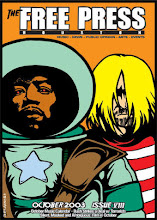The Fall

Despite seeing around 400 films a year, every year there's the one or two cinematic experiences that take my breath away and that compel me to see all the others. How else could I say with certainty that The Fall is an unparallelled success, a phantasmagoric series of images that takes the viewer on a journey into their own inner space? Consciousness is one of the traits of The Fall, it's narrative seems to have a life of its own.
Superficially The Fall recalls the structure of The Princess Bride in that the main story is being told as a kind of bedtime story to a young child. Only for The Fall we experience events as seen by a child's eyes, not the eyes of an adult. For instance when the narrator says "Indian and squaw" he means the American WIld West, only the little girl sees exotic natives from India. The main set piece is a Los Angeles hospital room in 1915. The man lying on a bed is a silent movie stunt man injured while performing a fall in the film's magnificent opening sequence. The entire beginning sequence takes place in slow motion, in black-and-white, and to the accompaniment of Beethoven's Allegro movement from his Symphony No. 7 in A Major. Other films that have used this sublime music, perhaps Beethoven's most moving moment where strings vibrate as emotions in harmony, are the endings of Zardoz and Irreversible, as well as Immortal Beloved natch. If Beethoven could collect royalties on this song alone, he would chalk up another payment as the strains of Symphony No. 7 were also used in the recent HBO series John Adams.
That The Fall's director Tarsem would choose such a classic orchestral piece that already has a history of use in films, and then imbue that scene (that introduces the film) with such stupendous cinematic treatment - we're talking Ashes and Diamonds, Raiders of the Lost Ark, 'O Lucky Man, this sequence blew me away - means I have to return to everything the guy has ever done because he just climbed way, way up on my list of favorite directors. Since The Fall is only Tarsem's second feature that would include his rock video "Losing My Religion" and his debut from 2000 The Cell. Sometimes you see a film and think the opening means this is going to be one of the best films you've ever seen. Then you see the film unravel in the middle and end. Not so in The Fall: the events start to be tres bizarre, the twists take their lead from real situations, the locations become more exotic and your own search for meaning in the character's choices seem more profound.
The main character, a little girl oozes so much charm and inquisitiveness, coupled with grace and love, that she makes little miss sunshine look like a debauched debutante. Her new friend, the bed-ridden stunt guy, uses her to steal morphine from the pharmacy. She willingly complies because that's the only way he will continue to relate the fantastical story he warbles.
The story within the story has the actors in and around the hospital playing a band of travelers seeking to revenge themselves against a despotic ruler. They traverse across a mystical landscape that includes swimming elephants, faces that morph into desert terrain, whirling dervishes, names like the Labyrinth of Despair and Governor Odious.
Technically The Fall fires on all cylinders. When you aren't being wowed by the story, the costumes are distracting you from the amazing locations. Tarsem evidently spent much of his money making this film, spent years doing it and utilized the kind of inspiration that comes from visiting some of the world's most captivating regions. If you can recall 70s films like El Topo, a metaphysical western, or Red Sun, where an international cast treks through the desert, you come close to what's on view in The Fall, but only approximately. Truthfully, the best reason to see The Fall is because there's nothing like it.









